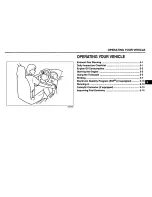
2 - About your vehicle
61
• To properly protect a child outside these
limits, specific restraint systems with
dedicated belts or accessories capable
of adapting the child’s position to the
vehicle’s seatbelts must be fitted.
For installation and use of any child
restraint systems, follow the instructions
provided by the restraint system
manufacturer.
Always follow the instructions supplied
with the child restraint system precisely.
Keep the instructions in the vehicle
together with the documents and this
handbook. Never use second-hand
child seats which are not provided with
instructions for use.
Always pull on the seat belt to check that it
is locked in place.
In case of an accident, replace the child seat.
No child under 12 should travel in
the front passenger seat.
Children must never travel seated on
a passenger’s lap. A child weighs very
little until a collision occurs! In a collision,
a child becomes so heavy that it would be
impossible to hold onto him or her. For
example, in the event of a collision at only
25 mph (40 km/h), a child weighing 12
lbs. (5.5 kg) exerts a force equal to 240
lbs. (110 kg) on the arms of the person
carrying him/her. Children must always be
protected by a suitable restraining system.
back. This is essential to help ensure the
maximum protection for the child.
To help ensure the best restraining action
of the child seat, we recommend that you
choose a seat that best suits the shape of
your vehicle’s seat and that you try to install
the child seat before purchasing it.
In the event of an accident, an
improperly fastened child restraining
system can increase the risk of injury.
Rearward-mounting child seats must
not be used on front passenger seats
equipped with airbags, as these could cause
serious injuries during deployment, even in
minor collisions.
No modifications can be made to the
seat belts and the child restraining
systems. Established legislation in some
countries already provides that children
under 12 years of age may not travel in the
front passenger seat.
The vehicle has been designed to allow
“Isofix” child car seats to be fitted. “Isofix”
is an additional feature, which does not
preclude the use of traditional children’s
car seats.
Due to the different fastening system, the
children’s car seat must be fixed using the
special brackets fitted on the vehicle.
Do not fit rear-facing baby seats on
the passenger’s seat if the airbag is
active, as the child risks serious injury if the
airbag is deployed.
Children (or adults) who are resting
on the airbag or are too close to
it when it is activated may be seriously
injured. The airbags and pretensioners are
designed to offer suitable protection for
adults and teenagers, but not for children
and babies. Neither the seat belts nor the
airbags are designed for them. Children
and babies must always travel in suitable
restraining systems.
Babies must be supported
completely, including their head and
neck. This is necessary since a baby’s neck
is weak while their head is proportionally
larger and heavier in relation to their
body. In a collision, if a baby is traveling
in a rearward-facing seat, the forces of
an impact are distributed throughout the
strongest parts of the body, i.e., the back
and shoulders. Babies must always be
protected by a suitable restraining system
when traveling.
Babies traveling in a rearward-facing
seat or children traveling in a child
seat may be seriously injured in the event
of airbag activation. This could happen
because the seatback of the child’s seat may
be positioned extremely close to the airbag
at the moment it is deployed. Never place
an infant or a child in the front passenger
seat at any time.
When installing a child seat on the
front passenger seat, the passenger
seat must be positioned all the way
Содержание 2006 F430 Spider
Страница 1: ...U S Version Model Year 2006 Owner s Manual ...
Страница 2: ...2 ...
Страница 6: ......
Страница 8: ...8 ...
Страница 20: ...20 ...
Страница 82: ...82 ...
Страница 116: ...116 ...
Страница 150: ...150 ...
Страница 151: ...7 Table of contents 151 ...
















































